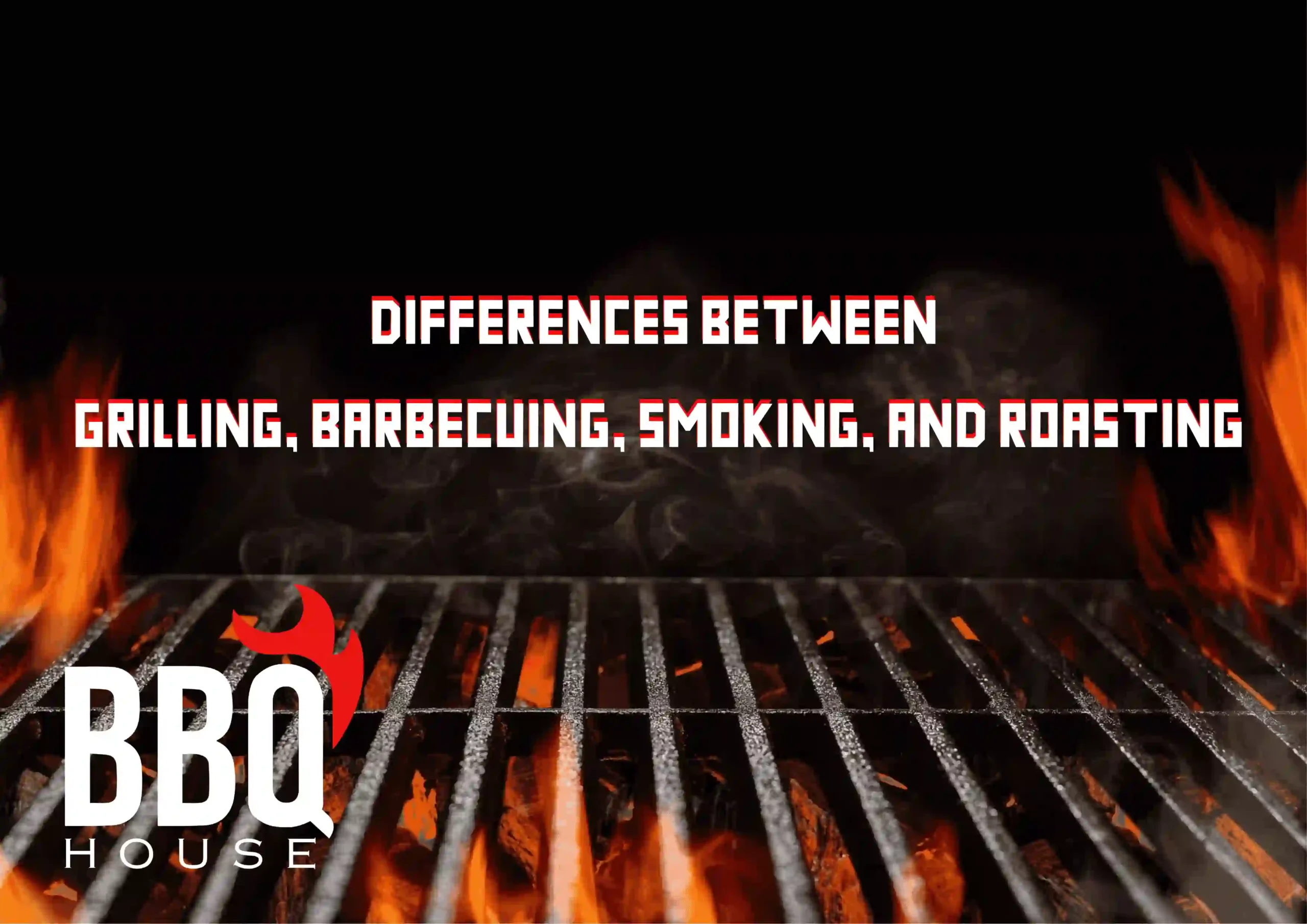Welcome to BBQ House!
Differences Between Grilling, Barbecuing, Smoking, and Roasting

When it comes to cooking meat, the world of fire, smoke, and heat offers a variety of methods, each with its own character, flavor, and cultural significance. Many people use the terms “grilling”, “barbecuing”, “smoking”, and “roasting” interchangeably, but the truth is that each is a distinct cooking style with unique techniques, flavor profiles, and traditions.
At BBQ House, we believe that understanding these methods is the first step toward appreciating the craft of premium grilling. Whether you’re a backyard cook experimenting with charcoal or a foodie seeking the perfect dining experience, knowing the differences can elevate your enjoyment of food and deepen your love for perfectly cooked meat.
-Grilling

Grilling is perhaps the most popular and widely recognized cooking method. It involves cooking food quickly over direct, high heat, usually on a grill with either charcoal or gas flames.
Key Features of Grilling
- High Heat, Short Time: Temperatures often reach 200–300°C, allowing food to sear quickly.
- Distinct Grill Marks: The hallmark of grilling is those beautiful charred stripes on the meat.
- Flavor Profile: Grilling creates a smoky, slightly charred exterior while locking in juices.
At BBQ House we offer you premium grills that gives the natural flavors of premium cuts. Whether it’s a juicy steak, tender chicken breast, or skewered kebab, grilling ensures maximum flavor with minimal seasoning.
-Barbecuing

Barbecuing, while often confused with grilling, is actually quite different. Instead of high heat, barbecuing involves low and slow cooking over indirect heat. This process can take several hours and allows tougher cuts of meat to become tender and flavorful.
Key Features of Barbecuing
- Low Heat, Long Time: Cooking temperatures usually stay between 90–120°C.
- Indirect Heat: The meat is placed away from the flame, relying on circulating heat and smoke.
- Flavor Profile: Deep, smoky flavors develop as the meat cooks slowly.
To measure temperatures you can get a food thermometer from our store now !
In culinary cultures worldwide, barbecuing is more than just cooking, it’s an event.
At BBQ House, this technique is honored in our approach to creating deeply flavorful, fall-off-the-bone tender dishes that showcase the art of slow cooking.
-Smoking

Smoking is the technique most closely tied to barbecuing but with an even greater emphasis on infusing smoke flavor into the food. The process can take anywhere from a few hours to an entire day, depending on the cut and the desired result.
Key Features of Smoking
- Fuel Source: Wood is the star of smoking, with each type—oak, hickory, applewood—adding its own aroma.
- Controlled Heat: Temperatures remain low, similar to barbecuing, but smoke plays the lead role.
- Flavor Profile: Rich, deep, and complex flavors that can’t be replicated by quick cooking methods.
BBQ House respects smoking as one of the most traditional and flavorful methods of preparing meat. It’s a style that requires patience and dedication, which is why it remains a favorite among true grilling enthusiasts.
-Roasting

Roasting is often seen as more of an indoor kitchen technique, but it has strong ties to grilling and barbecuing. Roasting involves cooking food in an oven or over an open flame at moderate to high heat. Unlike grilling or barbecuing, roasting is less about smoke and char and more about even cooking and caramelization.
Key Features of Roasting
- Even Heat: Typically done in an oven or covered space for consistent cooking.
- Versatility: Roasting works beautifully for large cuts of meat, poultry, and even vegetables.
- Flavor Profile: A tender inside with a golden, caramelized exterior.
At BBQ House, roasting inspires several of our approaches to preparing larger cuts, especially when the goal is to create a balance between tenderness and a crisp finish.
-Comparing the Four Methods
| Method | Heat Level | Cooking Time | Flavor | Best For |
| Grilling | High, direct | Fast (minutes) | Smoky, charred, juicy | Steaks, kebabs, chicken breasts |
| Barbecuing | Low, indirect | Hours | Deep, smoky, tender | Ribs, brisket, pulled meats |
| Smoking | Low, indirect with smoke | Hours to a day | Rich, complex smoky flavor | Brisket, ribs, large cuts |
| Roasting | Moderate to high, even | Moderate to long | Tender with caramelized exterior | Whole chicken, roasts, vegetables |
This comparison highlights how each method brings something unique to the table. At BBQ House, we celebrate them all, drawing inspiration to craft an exceptional dining experience for every guest.
Grilling, barbecuing, smoking, and roasting each offer a unique way to transform simple ingredients into unforgettable meals. While grilling delivers quick, flavorful results, barbecuing and smoking demand patience but reward you with unmatched tenderness and depth. Roasting, on the other hand, provides balance and consistency.
At BBQ House, these methods aren’t just cooking techniques, they are traditions we honor to serve the very best to our guests.
Follow us on Instagram and Facebook for more grilling info.
FAQs
What is the main difference between grilling and barbecuing?
Grilling uses high, direct heat for quick cooking, while barbecuing uses low, indirect heat for slow cooking.
Can smoking be done at home?
Yes, with the right equipment like a smoker or even a grill with a smoker box, you can smoke meat at home.
Does roasting always require an oven?
Not necessarily. Roasting can also be done over an open flame or in a covered grill, but ovens are the most common tool.
Which method gives the most smoky flavor?
Smoking is the most smoke-intensive method, offering the deepest and richest flavors.
Why does BBQ House use different cooking methods?
Because each method creates a unique flavor and texture, allowing BBQ House to serve a diverse menu that celebrates the art of grilling and beyond.




